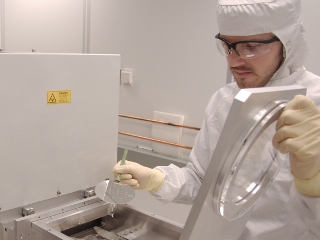Oct 13 2015
Montana State University’s Optical Technology Center, or OpTeC, beat out programs at two much larger universities to win a top economic development award for its role in the development of a high-tech laser and optics business cluster in Montana.
 Electrical engineering student Erwin Dunbar works with a silicon wafer in the Montana Microfabrication Facility at Montana State University. The lab is one of many operated by OpTeC faculty. It is also used by members of industry. MSU photo by Kelly Gorham.
Electrical engineering student Erwin Dunbar works with a silicon wafer in the Montana Microfabrication Facility at Montana State University. The lab is one of many operated by OpTeC faculty. It is also used by members of industry. MSU photo by Kelly Gorham.
The “talent development” award was given to OpTeC by the University Economic Development Association at its recent annual meeting in Anchorage, Alaska.
The award focuses on the partnerships needed between a university and industry to meet workforce needs, according to the UEDA.
“OpTeC has developed and attracted talent, it is on the cutting edge of photonics innovation, and works closely with companies, receiving contracts that help sustain the research efforts. By moving talent into positions much more lucrative than the average salaried positions in the area, it has helped transform Bozeman into a recognized optics and photonics center,” the UEDA noted in its press release about the award.
MSU competed against finalists Washington State University, the University of Southern Indiana and Iowa State University to win the award. WSU and ISU have enrollments of more than 28,000. MSU’s fall enrollment is 15,688.
“This award isn’t just about MSU, it is about all the companies OpTeC has worked with over the past 25 years. Our success has been through working together. We’re very grateful to our industry partners, many of whom are also our former students,” said Joe Shaw, OpTeC director.
“This is another example of how MSU’s research activities impact the economy of Montana,” said Becky Mahurin, director of MSU’s Technology Transfer Office. “The more students who are educated, the more companies and jobs that are created.”
MSU created OpTeC in 1990 to collaborate with a small handful of laser optics companies in Bozeman in the areas of physics, chemistry and electrical engineering. The collaboration steadily grew, as did the number of companies.
Today, more than 200 graduate students and 300 undergraduate students have been educated through OpTeC. Bozeman now boasts more than 30 optics/photonics companies employing more than 500 people, 80 percent of whom are MSU graduates. Average salaries exceed $60,000, which is almost double the average salary across the board in Montana, Shaw said.
“The companies work on technologies as diverse as remote sensing, growing crystals that are utilized in applications for NASA, to medical imagining and therapy, to technologies that increase safety for firefighters, to night vision technologies, and many more,” said Shaw. “The technologies are increasing the quality of life for many, and the jobs are increasing the opportunities in high technology for MSU graduates and others. The existing companies are serving as mentors to new startups, perpetuating the impact on the regional economy.”
MSU won the award for its concerted efforts in optics research with industry connections and in educating and providing a workforce for this high-tech sector. Much of that effort was in producing master’s degree and doctoral degree graduates in the areas of physics, electrical engineering and chemistry. But just within the last year, MSU has also created a minor in laser and imaging optics and a master’s degree in optics and photonics to meet workforce demand.
Additionally, MSU’s two-year college, Gallatin College, is in the process of developing a two-year certificate program to meet the need of optics technicians.
MSU currently has more than 20 researchers across several departments that participate in OpTeC.
In August, MSU also received nearly $2.5 million from the Montana Research and Economic Development Initiative for research into compact optical sensors that could be used in everything from precision agriculture to advanced imaging for detecting skin cancer. Shaw is the project’s lead researcher. The initiative is the state of Montana’s first large-scale research initiative. Proposals that won funding through the $15 million initiative needed to meet one or more of the following criteria: to address a Montana problem; to create Montana jobs in existing economic sectors; or to help spur new companies in Montana.